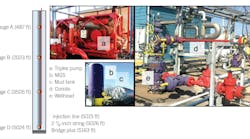New oil field marking system
Here's the XF530m permanent marking system designed for use on oil field tubing and pipeline, lifting equipment (pallet trucks, forklift trucks), work vehicles, boat building, or structural steelwork.
All that is required for operation is a standard electrical supply of 90-230 v. Quiet in operation, this equipment features flexibility and ease of use. Whether being used on tubular goods or a flat surface, all that is required is to position it on the part, without the need for any other clamping or positioning tools. The tool has a large marking field measuring 200 by 50 mm and is equally efficient at marking texts, logos, dates, and variables, the firm says. Marking can be flat, angled, or radiating, and various font typefaces are available.
The unit is ergonomic in design. Marking trigger buttons are positioned on the machine's grab handles so that it can easily be held in position during the marking process.
Its detached control unit is designed to be used anywhere in the world. To date, the interface can operate in more than 20 languages. The integrated control software is intuitive and user friendly, helping to make it quick to set up a new marking template. There is also a large backlit screen to provide a quick view of the resultant marking.
Fitted with the latest generation of communication tools, the XF530m has a range of connection interfaces (RS232, Ethernet, and 8-in/4-out) so that links can be established with the computer network and assembly line PLC. A USB memory stick can be used to import and export templates and logos. It has sufficient memory capacity to store more than 1,000 marking templates.
Source: Technifor Inc., 9800-J Southern Pine Blvd., Charlotte, NC 28273.
Upgraded interface for distributed control system
An upgrade to this firm's own-developed interface to Tokyo-based Yokogawa Electric Corp.'s Centum distributed control system (DCS) platform is on the market.
New features of the interface include:
- Added support for the integrated safety system Prosafe-RS.
- Displays for field bus devices are fully functional, with control calculations being performed by blocks in the process model.
- Maximum number of controllers (field control station and safety control station) has been increased by 50% and now supports as many as 48 controllers.
- Hardware alarms for all control functions can be configured and controlled by the instructor. The safety system includes checks on transmitter health as part of logic.
- Significant operator actions are recorded in a journal that can be edited and replayed. This can be used to automate operator actions or as part of a training exercise.
Supporting tools have also been updated:
1. Spreadsheet tool has simple configuration block allowing engineers to select variables within each block control type. This has been used to preserve controller tuning constants, when models are updated.
2. New DCS start-up and health monitoring tool provides a visual indication of progress and state of each controller. It also has support for multiple DCS hardware configurations helping to make it easy to switch between process sections.
Source: Hyperion Systems Engineering PLC, 38 Strovolou Ave., CY-2018 Nicosia, Cyprus.
New service helps optimize wellbore placement
Newly launched reservoir navigation services (RNS) is intended to optimize wellbore placement via combination of reservoir modeling, a comprehensive real-time drilling evaluation tool kit, and 3D-4D visualization software with interpretation specialists.
The service is designed to optimize production and increase overall asset recovery by reducing uncertainty during drilling and delivering maximum reservoir contact in the targeted zone.
RNS includes a prewell planning process that integrates multiple offset-well and digital horizon data into a 3D geospatial model of the reservoir's anticipated stratigraphy. Proposed well plans are verified against the model's structural data, which is then used as input to this firm's reservoir navigation software to create a predictive model that anticipates real-time tool responses to the expected stratigraphy. Additional forward models are built to test alternative geological interpretations, to qualify geological model reliability, and to identify any potential weaknesses in the geological interpretation. Data from the various models are used to map the well in the zone of maximum interest.
During drilling operations, real-time, high-transfer rate survey and logging-while-drilling (LWD) data are captured and continuously entered into the reservoir navigation software. Customized plots present the data in its geological context on measured and stratigraphic depth scales.
RNS uses a full suite of LWD tools. The formation evaluation technology incorporates high-speed telemetry so data capture does not interfere with drilling time. Data interpretation and geosteering experts located at the wellsite, in the client's office, or in one of this firm's BEACON collaboration centers use the constantly updated geologic model and geosteering capabilities to overcome real-time drilling challenges.
Source: Baker Hughes Inc., 2929 Allen Parkway, Suite 2100, Houston, TX 77019.
More Oil & Gas Journal Current Issue Articles
More Oil & Gas Journal Archives Issue Articles
View Oil and Gas Articles on PennEnergy.com

